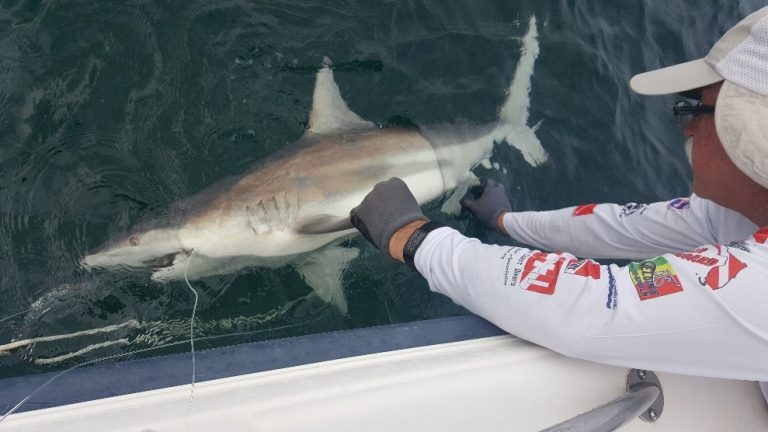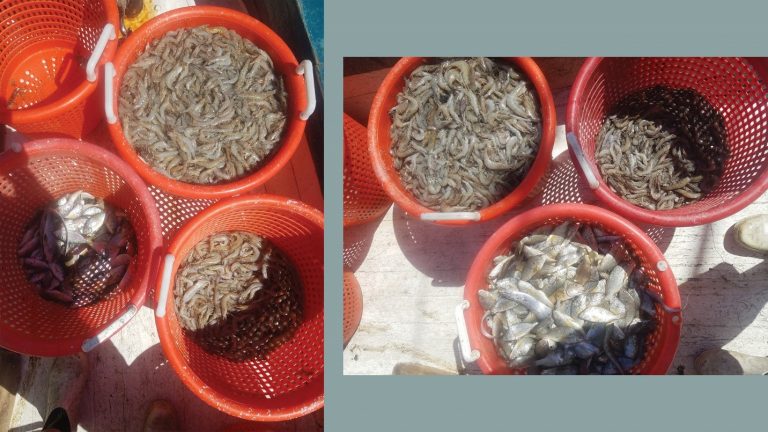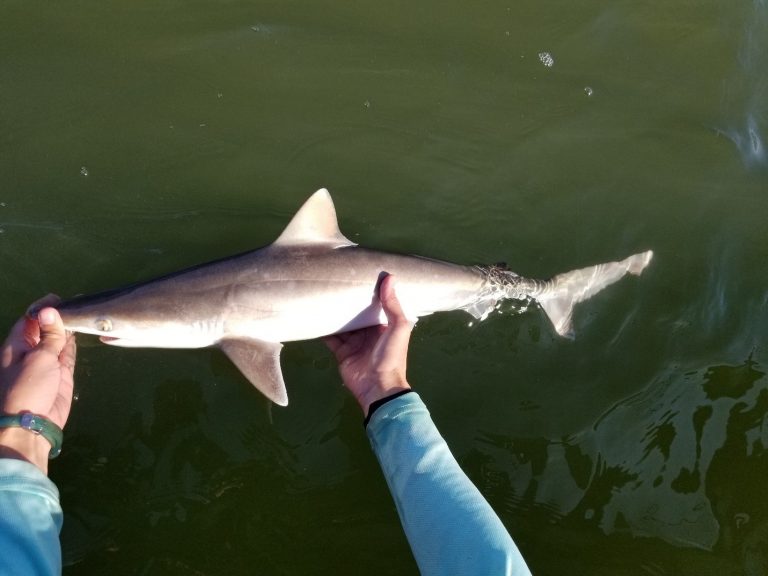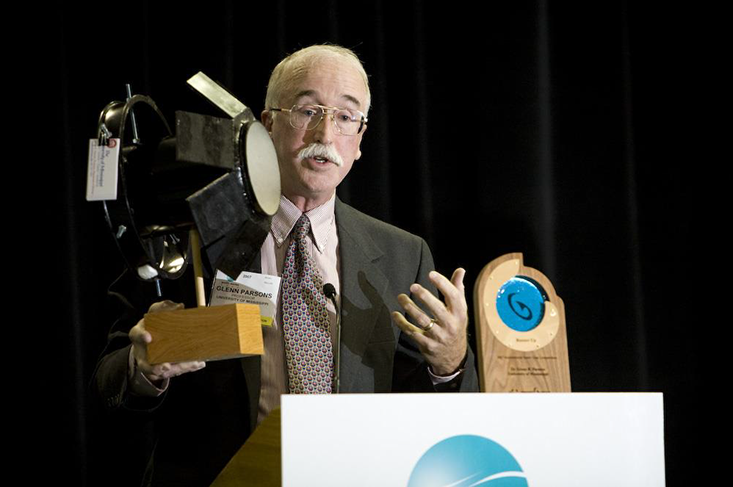Written by Sean Beckwith, PhD student
Introduction
Dr. Glenn R. Parsons, CMS alumnus, Class of 1987, is Professor of biology and Director of the University of Mississippi Center for Biodiversity and Conservation Biology
Advisor at CMS: Dr. John C. Briggs
Glenn Parsons earned his Ph.D. in biological oceanography in 1987. He was initially interested in electrosensitivity in sharks, an ability that humans do not possess, but later changed his research focus to shark reproduction and ecophysiology. He worked with live sharks in holding lagoons at a research facility, The Shark Institute, built in the Florida Keys by Sea World. That institute is now the Keys Marine Lab, operated jointly by the Florida Institute of Oceanography and USF. Parsons was not only the first researcher to utilize the facility opened by Sea World, but he also became the first person to capture video of sharks being born. In later years, his work shifted to physiological characteristics of sharks and how those characteristics vary latitudinally from Tampa Bay to Florida Bay, with a focus on hammerheads. In his current role he uses many of the same techniques he learned during his time at the College of Marine Science (then the Department of Marine Science), but of course he has expanded his toolkit in the last 30+ years.
Q & A with Dr. Glenn Parsons
Q: Do you have a favorite memory from CMS?
A: I have so many fond memories it’s hard to choose one of them. I think about St. Pete all the time and still have friends there.
One memory I think about often is when I first met my advisor Dr. Briggs in his office, he was just super nice, very laid back, very gentlemanly. His office was his personal library. He had books from the floor literally to the ceiling and I was just blown away. He had the largest personal ichthyological library in the Southeast at the time, maybe even the U.S. It was huge. He ended up later donating a lot of it to the USFSP Poynter Library (the John C. Briggs collection).
It was amazing for me to walk in there because here I was just a lowly graduate student, and he starts pulling books off the shelf and placing them in my hands – you know, I felt like I should be wearing white gloves. The books were really, really valuable, some to the tune of $20,000. He had a book from something like the 1500’s, which was the first scientific book ever published about fishes. He handed me another book, one of a multiple volume set called Atlas Ichthyologique by Pieter Bleeker from the 1800’s, and it is one of the most spectacular works on fishes ever produced. I think about that all the time, the fact that I was holding some of these books. Some of them are now in the Smithsonian.
Q: What has been the most valuable aspect of your CMS education?
A: It was probably the interdisciplinary aspect of CMS. We had to take biological oceanography, chemical, physical, and geological oceanography even though I thought I’d only take biology classes. But since I started to teach oceanography, that has helped me immensely. I had no trouble at all putting together courses in oceanography. Plus, my work is interdisciplinary. The work that really changes our way of looking at things is typically done by those that are looking at the big picture. And to look at the big picture, you’ve got to have that skill set from a variety of disciplines.
The other, more practical sort of thing is the location of the College of Marine Science. For a person that does field work, location is really important. Where I’m at now is about a 6 hour drive from the coast, and while it’s not something that stops me from doing my work, it is a hassle. It doesn’t limit me so much in the research aspect, but in terms of teaching, it definitely does. You can’t just pop over to the marsh or drive over to the beach and have a little day trip.
Q: Have there been any surprises along the way in your career path? Or, what were the biggest eye-openers?
A: In the beginning, and this is true of all starting professors, one of the hardest things is that I understood the role of the professor as being an educator. When you first go into the classroom, you think you’re gonna give a lecture. Well, anyone can give a lecture, but being an educator is different. You’re not a fountain of information, and you’re not just delivering facts. A real teacher has to understand a variety of things, like how to gauge their audience. It takes a few years. I can now look at a room after I’ve spoken to them and I can tell, OK, that didn’t work. I’m not getting across to them. You have to be able to change what you’re doing on the fly.
So going from being a new graduate, being able to deliver a lecture, to actually being a teacher and an educator was a big transition for me. That was one of the surprises for me.
Q: Are we moving the needle on the shark conservation dial? Is it moving quickly enough?
A: We are moving the needle, yes. But we are not moving quickly enough. It takes forever to get things done, it seems. However, if we look at the status of sharks back when I first started in this field…nobody cared about sharks at all. If I told someone about the shark biology I was working on, they would ask me, why? There was really no interest at all. Sharks were mostly seen as something to get rid of—not so much by scientists but by the general public. And then of course there was the whole Jaws thing, which really didn’t help the conversation much at all. The public in general just really didn’t have much of an opinion about sharks other than fear and ‘What good are they?’
The attitude among much of the public regarding sharks and their relationship to humans has really changed over the past 20 or 30 years. There’s still fear, for some people, but even people that fear sharks recognize the importance of these animals in marine ecosystems. Sharks have entered the psyche of people. Most understand that they’re important, that you can’t just go out and eradicate sharks. If you do, you’re gonna change ocean ecosystems in ways that are very unpredictable and deleterious. These days we also have management programs in place, so yeah, we’re doing a lot better.
I don’t think we’re moving quickly enough, though. A lot of times government regulations have to be put in place, some kind of fishery management, and a lot of times it just takes a while to get these things done.

Glenn Parsons examining a blacktip shark. Photo credit: Parsons’ lab
Q: Who is your main target audience these days and where are you most effective?
A: It’s really multi-targeted. I’m pursuing politicians on one end. I also work with managers, the fisheries managers, and the administrators that have to approve anything I’m suggesting. If I recommend a device for commercial fishing that reduces the catch of non-target species (bycatch), it has to go through a certification process, and that process can take years. And even when it gets to the point to where it’s ready to go out on fishing vessels, there’s no guarantee that people are going to use it. Even if it’s better for the environment, it’s better for the fishers, it’s better for their quality of product…It can be frustrating.
The best thing for me to do, in my opinion, is for me to conduct the research to document problems. One of my strengths is problem solving. In my research, that is one of my favorite things to do. In fact, I’ve become obsessed with problem solving. If somebody says, look we’ve got this problem with bycatch in the tuna fishery – shark bycatch, which is one of the things that I’ve been working on – then it’s almost like I become obsessed about it. I wake up thinking about it, I go to bed thinking about it.
Q: You’ve worked on Bycatch Reduction Devices (BRDs) for sharks and shrimp… Are there others? Where is most of your effort focused these days, in terms of BRDs?
A: Those are the only two I’ve been working on currently. Basically, the shrimp device goes into a shrimp trawl, and it eliminates 40 to 50% percent of bycatch. It works really well. The bycatch in the Gulf of Mexico is a real problem. At one time, the Gulf of Mexico shrimp trawl fishery was ranked 5th in the world in terms of bycatch. It’s something like, for every pound of shrimp that is caught, 4 to 5 pounds of other animals are captured. We reduced that to almost 50%, so 2 to 2 ½ pounds of bycatch to 1 pound of shrimp. Global bycatch discards are just crazy: 63 billion – that’s billion with a ‘B’ – pounds of bycatch per year! That’s about a 40% discard rate. It’s wasteful. Clearly it’s bad for the environment.
Federal fishers are required to use a bycatch reduction device (BRD), and the one that’s the most popular loses about 10-12% of their shrimp. Our device loses only 1-2% of the shrimp. It costs a bit more, but it pays for itself, assuming you catch shrimp, in about one night of trawling. It’s already paid for in one night.
I’ve been working on that device for several years with colleagues of mine at the Pascagoula, MS, lab of the National Marine Fisheries Service. That is the lab that created the turtle exclusion device, and it’s the same lab where I’m working on the shrimp BRD but also the shark BRD.
I’ll be working on the shark bycatch device again soon, depending on a proposal that I’ve submitted. Basically, I’ll be researching the idea that we change the kind of leader that the fishermen use. They use a 300 lb. test monofilament line that primarily catches tuna, but also catches shark. The sharks are caught, hauled to the boat, and of course they let them go. But, unfortunately, they’re already stressed to the point that they probably don’t recover.
I am investigating a different kind of line called Spectra that is really high test. It’s made from something called ultra-high molecular weight polyethylene, which allows you to have a thinner line with a much heavier load. A line made of 300 lb. Spectra is probably about a third of the diameter of 300 lb. monofilament. But if you put a load on that line and just touch it with a blade, it breaks –it cuts –really easily. Sharks cut the line, they swim away. Tuna do not because their teeth are completely different. So we retain the tuna and allow the sharks to swim away.
For more information, visit Dr. Parsons’ Bycatch Reduction Research website. (Dr. Parsons’ lab is currently providing a free BRD to shrimpers that might like to try the device and, as long as funds last, will provide a $250 honorarium to try it.)

A comparison of a shrimper’s haul with (left) and without (right) the shrimp trawl bycatch reduction device. These photos reveal the drastic reduction in the amount of bycatch (small fish, in this case). Photo courtesy of Glenn Parsons.
Q: Can you explain the legislation that concerns the banning of trade in shark fins?
What is the current status?
A: Banning the trade of shark fins has been reintroduced, with cosponsors already supporting the bill in the House of Representatives. A similar bill has been created in the Senate. It’s officially called The Shark Fin Sales Elimination Act, and it is Senate Bill S.877 and House Resolution H.R.737. Trading in shark fins, which are used in shark fin soup, is not yet illegal federally, but 12 states have slowed the sale of shark fins by banning at the state level. So, finning – the act of removing a shark’s fin and throwing the shark back in the water – is illegal in the U.S. and is illegal in many parts of the world. However, the trade of fins from sharks that are taken whole (and transported back to market) is legal in the U.S. The problem, however, is there is no enforcement of anti-finning regulations in many places. Therefore, fins that have been taken by finning in various parts of the world enter the market and some of those fins end up in U.S. markets. There is no way to determine which fins were taken legally and which were taken by cruel, wasteful finning. There will always be poachers out there, but we’ve gotta do something. And the only thing we can possibly do is say, “We’re not gonna participate in this anymore.”
While some shark fin soup is still consumed in the U.S., it’s becoming less and less accepted here and in other places in the world. The fins from 75 million sharks are taken each year, worldwide. This is a major contributor to the declines in shark populations that we have witnessed over the past 30 or 40 years.
Unfortunately, it is very attractive for fishers to break the law in this regard when you consider that they have a choice of keeping the flesh, which takes up a lot of space on a boat at 50¢ or so a pound, versus filling that space up with something that brings $650 a pound. You know, there’s really not much of a decision for them to make.
Florida is kind of a holdout because there are a lot of commercial shark fishers in Florida, and they trade the fins, but I was pleased to see that one senator from Florida supports the legislation.
See Dr. Parsons’ testimony before Congress.

One of Parsons’ students holding a blacktip shark. Photo credit: Parsons’ lab
Q: When did you realize you needed to take your ideas and create patentable products?
What were some of the hurdles faced there? How rewarding has that been?
A: That was a little bit problematic for me. It was rewarding in that it gave me a sense of accomplishment. But the biggest hurdle is the paperwork involved. I did it all myself; I didn’t hire a patent attorney. And at the end of the day, it wasn’t as bad as I thought it was going to be – primarily because there was a fellow in the U.S. Patent Office who was my agent (they give you a person to communicate with), and I wanted to send him a bouquet of flowers or something. He really helped me. Patent language is very weird, and he helped me rewrite the patent where needed.
So, it was a sense of accomplishment, and it was really at the request of several scientist friends of mine who said, “You need to patent that.” And I had too many people tell me that for me not to patent the shrimp trawl BRD. So, I did it. It was a good learning experience for me, but the problem is that I have to get fishermen to accept it. That has been a big problem so far, yet I remain the eternal optimist.
Q: What was your inspiration for writing Cherokee Summer?
A: My inspiration for Cherokee Summer was, in two words, “My dad.” He had a lot of crazy stories and I said I’m gonna’ put all these together into a short novel. And, it’s really meant for the 12 to 18 year-old group. It’s got some crude stuff in it – you know, kids can be crude – and, it’s perfectly appropriate for that age group, but the interesting thing is that I wrote it for that age group and adults have bought it. They’ve told me that they just thought it is great. It’s meant to be more of a comedy, kind of, you know, funny misadventures kind of thing.
I’m writing another novel. This one is definitely not for the 12 year olds. It’s called Night Fishing. It’s kind of a Michael Crichton, Stephen King kind of thriller/horror type novel. It’s meant to be anyway. Who knows, it may flop. I don’t know, but it’s not real high on my priority list right now. I’ve got too many other things going on.
Q: And how about your other book, the field guide, Sharks, Skates, and Rays of the Gulf of Mexico?
A: It’s doing well. I’ve sold several thousand copies of it. It’s been ranked #1 on Amazon several times for “fish book,” or ichthyology, for shark book, etc. For just a small field guide, people have really liked it.
I’m actually writing another book, and I’m dedicating it to Dr. Briggs. It’s called The Fishes: An Ecophysiological Approach. For that one, I’ve got a publisher (Cambridge Press) and a deadline on it, so it will be published.
